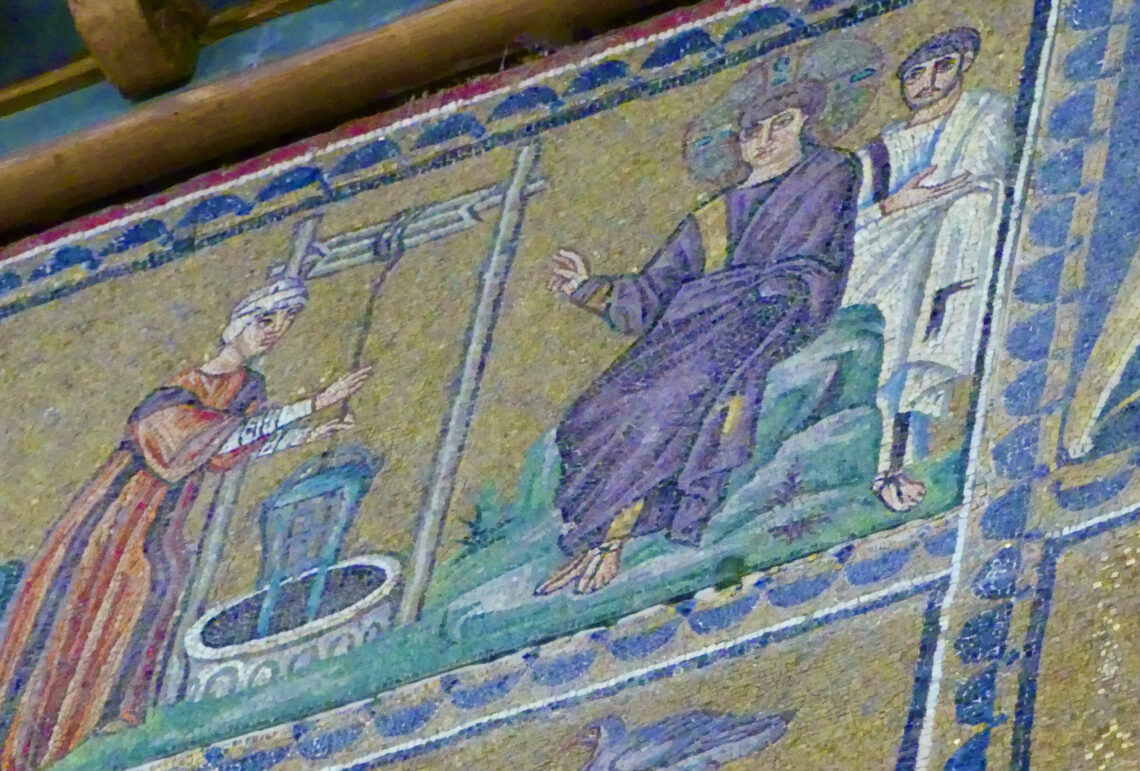
Women’s History Month: Meet Some Female Martyrs from the Early Church
When I spoke to a class of seminary students recently about women in public ministry in the early church, someone asked me to share some names and narratives about our foremothers. It seemed fitting to provide a sampling here during Women’s History Month. (Some day I hope we will simply learn “history”; but until women are included in the telling of history, we’ll continue to need a special annual focus.) You can find all the women listed below in the mosaics of Ravenna’s “new” (6th c) Basilica of Sant’Apollinare. I’ve included a summary of the stories that usually accompany them, as well. You will notice a theme of women exercising agency over their own bodies to the glory of God.
Agatha. Virgin martyr. Agatha died in 251. Born in Sicily into a noble family, she steadfastly vowed to remain a virgin. She was taken to a house of prostitution, tortured by rods, hooks, the rack, and fire. She died after being rolled over coals and sharp broken pieces of pottery.
Agnes. Virgin martyr. As a child, Agnes committed herself to God. At age thirteen she was killed by the swift stroke of the executioner’s sword.
Anastasia. Virgin martyr. The Roman daughter of a nobleman, Anastasia was forced to marry an unbeliever. She often disguised herself as a man to minister to Christians in jail. When her husband found out, he imprisoned her—along with three maids—and threatened to starve her. But he died, and she was released. Anastasia was later burned alive. She has been described as “one of the most highly venerated” of the church of Constantinople.
Anatolia and Victoria. Virgin martyrs. Sisters. During the reign of Decius, they refused to recant and died from sword wounds.
Cecilia. Virgin martyr. Cecilia took a vow of chastity as a girl. Her parents betrothed her to a man who, upon learning of her vow, was baptized on what was to be their wedding day. Cecilia proclaimed the good news and is said to have summoned 400 people to her home, where they were baptized. It took three attempts on her life to kill her.
Crispina. Martyr. Raised a Christian by her noble family, Crispina was accused of disregarding edicts. The proconsul tried to get her to recant her faith by threatening her with death. “Crispina replied that she cared not for this life,” and was beheaded in 304. Augustine held her up as a model for Christians, as she gave up luxury and ease for eternal glory.
Cristina. Virgin martyr. Cristina’s father, a Roman patrician, had her beat and imprisoned at age 12 for refusing to sacrifice to a god. His successor ordered her tongue cut out and had her put in a dungeon with snakes. Bound to a tree, she was impaled with arrows.
Daria. Virgin martyr. An educated young woman from Athens, she had a fiancé who converted to Christianity and was baptized. They were arrested, put in separate prisons, tortured, and sentenced to die. Both were tossed in a pit and covered with dirt and stones—buried alive.
Emerentian. Virgin martyr. Known as the foster-sister of Agnes, she was stoned to death while confronting pagans at Agnes’s burial place.
Eugenia. Virgin martyr. She left a life of privilege to enter a monastery and, upon the abbot’s death, was elected as his replacement. She was later beheaded for her faith.
Eulalia. Virgin martyr. At age twelve, she refused offers of marriage, choosing to remain a consecrated virgin. Her parents hid her at their country home, but she escaped and publicly delivered a courageous message. She was burned to death by flaming torches.
Euphemia. Virgin martyr. During Diocletian’s persecutions, Euphemia wore black and renounced worldly goods and pleasures. A judge tried to get her to recant at age 15, but she refused, so she was tortured on a wheel, but the wheel broke. She was thrown to wild beasts, but they ignored her. She is said finally to have been struck on the mouth with a hammer.
Felicity. Martyr. Enslaved and pregnant, she gave birth two days after her arrest. Her labor and delivery of a preterm baby girl was celebrated, as fellow believers had prayed for such an outcome. Per her wish, Felicity died in the arena together with St. Perpetua and other believers. A Christian woman adopted and raised her daughter in the faith.
Justina. Virgin martyr. Born in Padua, Italy, Justina was raised in a Christian family. Her father, a king, was said to have been baptized by a disciple of Peter. After her father’s death, the emperor pressured Justina to renounce her faith. When she refused, she was put to death by sword.
Lucy. Virgin martyr. Lucy died in 304 under Diocletian. She sold her belongings and gave the money to the poor. She was arrested and brought before a judge, who commanded her to sacrifice to idols. She died from a sword through the neck.
Paulina. Virgin martyr. Paulina’s family witnessed her mother’s miraculous healing and converted with three hundred others. Father, mother, and daughter were martyred for their faith.
Perpetua. Martyr. Perpetua was educated. She converted to Christianity despite her father’s objections. Her father was beaten due to her confession of faith, but she still refused to recant. Perpetua was married and still nursing a baby when arrested. She died a martyr in the arena of Carthage, alongside her servant, Felicitas. Perpetua’s account of her experience has earned her the designation as the first known Christian female writer.
Savina. Third-century martyr and widow of Milan. Upon her husband’s death, Savina helped victims of persecution under Diocletian, even burying their bodies in her own home. Found praying at their tombs, she was martyred.
St. Pelagia. Virgin martyr. To defend her virginity, at age 15, Pelagia—born in Antioch—took her own life in 311. When soldiers arrived to arrest the girl at her father’s home, she said a prayer and jumped into the sea.
Valerie. Widow and martyr. In first-century Ravenna, Valerie married Vitalis, who was tortured and buried alive. (Justinian built a church in Ravenna to honor him—the Basilica of San Vitale.) When Valerie refused to participate in a pagan festival, villagers beat her to death.
These are women of whom the world was not worthy. May we follow them as they followed Christ.
Special thanks for Cynthia Hester for her help with research.
I shot the cover photo in 2017 in Ravenna of a mosaic in the Basilica of Sant’Apollinare Nuevo. It depicts Jesus with the woman at the well/Samaritan woman. According to tradition, her name was Fotina, and she was martyred.



